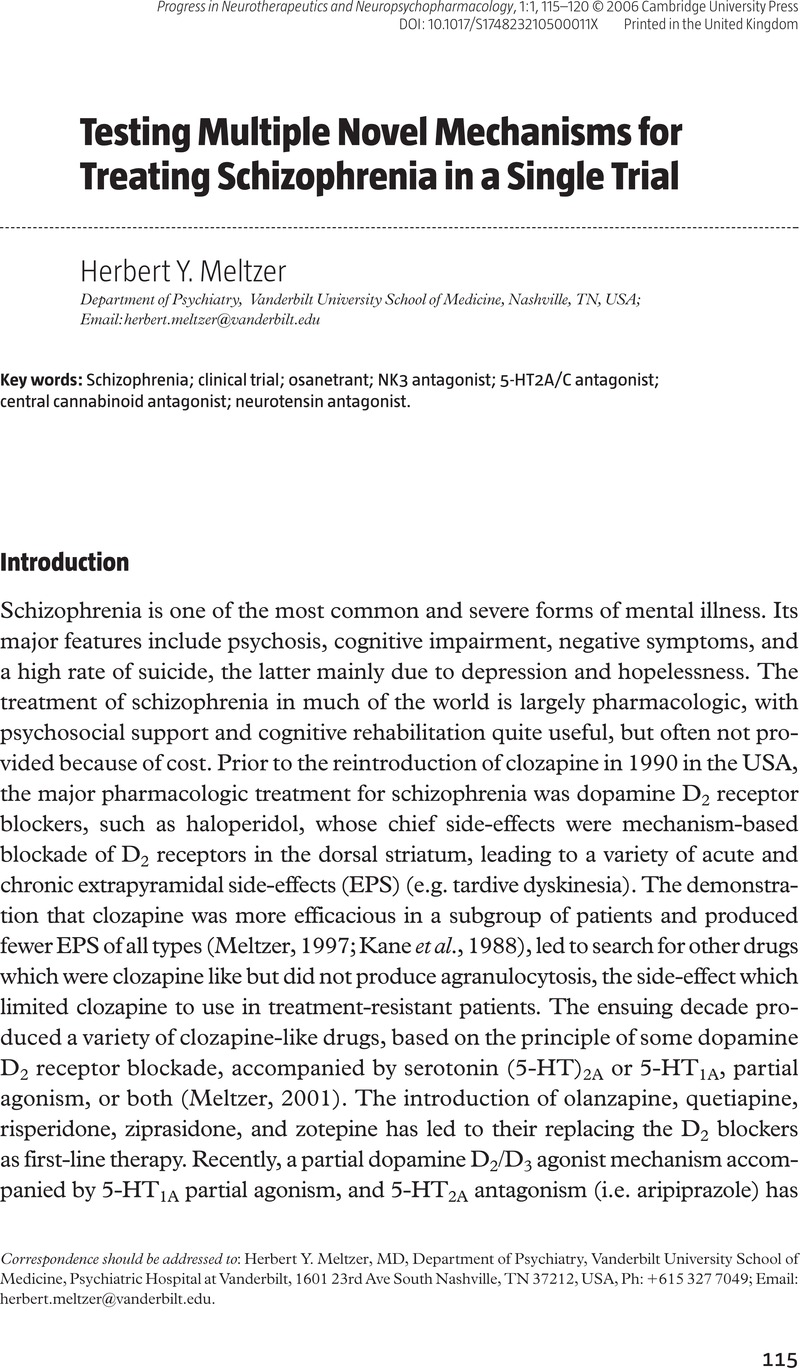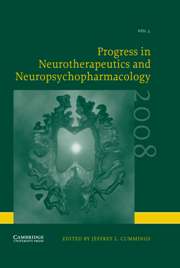No CrossRef data available.
Article contents
Testing Multiple Novel Mechanisms for Treating Schizophrenia in a Single Trial
Published online by Cambridge University Press: 02 March 2006
Abstract
An abstract is not available for this content so a preview has been provided. Please use the Get access link above for information on how to access this content.

Keywords
Information
- Type
- Review Article
- Information
- Progress in Neurotherapeutics and Neuropsychopharmacology , Volume 1 , Issue 1 , January 2006 , pp. 115 - 120
- Copyright
- © 2006 Cambridge University Press
References
Bonaccorso, S., Meltzer, H.Y., Li, Z., Dai, J., Alboszta, A.R., & Ichikawa, J. (2002). SR46349-B, a 5HT2 receptor antagonist, potentiates haloperidol-induced dopamine release in rat medial prefrontal cortex via 5HT1A receptor activation. Neuropsychopharmacology, 27, 430–441.Google Scholar
Boules, M., Fredrickson, P., & Richelson, E. (2005). Neurotensin agonists as an alternative to antipsychotics. Expert Opinion Investigational Drugs, 4, 359–369.Google Scholar
Kane, J., Honigfeld, G., Singer, J., & Meltzer, H.Y. (1988). The Clozaril Collaborative Study Group. Clozapine for the treatment-resistant schizophrenic: a double-blind comparison with chlorpromazine. Archives of General Psychiatry, 45, 789–796.Google Scholar
Kay, S.R., Fiszbein, A., & Opler, L.A. (1987). The Positive and Negative Syndrome Scale (PANSS) for schizophrenia. Schizophrenia Bull, 13, 261–276.Google Scholar
Meltzer, H.Y. (1997). Treatment-resistant schizophrenia – the role of clozapine. Current Medical Research and Opinion, 14 (1), 1–20.Google Scholar
Meltzer, H.Y. (2001). Serotonin as a target for antipsychotic drug action. In: Breier, A., Tran, P., Herrea, J.M., Tollefson, G.D., & Bymaster, F.P. (eds.), Current Issues in the Psychopharmacology of Schizophrenia, Chapter 17. Philadelphia: Lippincott Williams & Wilkins Healthcare, pp. 289–303.
Meltzer, H.Y. (2005). The metabolic consequences of long-term treatment with olanzapine, quetiapine and risperidone: are there differences? International Journal of Neuropsychopharmacology, 8, 153–156.Google Scholar
Meltzer, H.Y., Arvanitis, L., Bauer, D., & Rein, W. (2004). A placebo-controlled evaluation of four novel compounds for the treatment of schizophrenia and schizoaffective disorder. American Journal of Psychiatry, 161, 975–984.Google Scholar
Poncelet, M., Barnouin, M.C., Breliere, J.C., Le Fur, G., & Soubrie, P. (1999). Blockade of cannabinoid (CB1) receptors by 141716 selectively antagonizes drug-induced reinstatement of exploratory behaviour in gerbils. Psychopharmacology (Berl), 144 (2), 144–150.Google Scholar
Roth, B.L., & Xia, Z. (2004). Molecular and cellular mechanisms for the polarized sorting of serotonin receptors: relevance for genesis and treatment of psychosis. Critical Reviews in Neurobiology, 16, 229–236.Google Scholar
Spooren, W., Riemer, C., & Meltzer, H.Y. (in press). NK3 receptor antagonists: the next generation of anti-psychotics? Nature Reviews Drug Discovery, 2005; 4: 967–975Google Scholar
Woodward, N.D., Purdon, S.E., Meltzer, H.Y., & Zald, D.H. (2005). A meta-analysis of neuropsychological change to clozapine, olanzapine, quetiapine, and risperidone in schizophrenia. International Journal of Neuropsychopharmacolgy, 8, 1–16.Google Scholar

